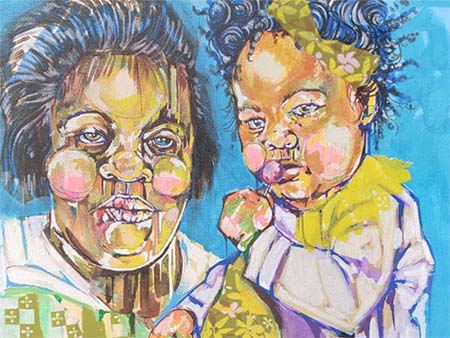 Lynthia Edwards' "Granny's Baby"Artist Lynthia Edwards of Pinson, Alabama, has been awarded an Individual Artist Fellowship of $5,000 from the Alabama State Council on the Arts.
Lynthia Edwards' "Granny's Baby"Artist Lynthia Edwards of Pinson, Alabama, has been awarded an Individual Artist Fellowship of $5,000 from the Alabama State Council on the Arts.
Edwards is a graduate of the University of Alabama at Birmingham, where she earned a master’s degree in arts education, studying with Gary Chapman, professor of painting in the College of Arts and Sciences’ Department of Art and Art History.
Chapman says, with 30 years of teaching experience, he has seen much talent come through the painting studio at UAB, and Edwards stands among the “super-talented students who are more than memorable.”
“Lynthia has developed a beautiful and seductive technique, a strong voice and a very powerful body of work,” Chapman said. “But what stands out beyond talent is Lynthia’s incredible work ethic. She is tremendously productive. There is a fire in her, and her paintings are the direct result.”
Edwards works primarily in acrylic on board, using vibrant colors in a technique that embraces paint drips, beautifully rendering portraits of Black girls. Her work is rapidly growing in recognition and acclaim throughout the Southeast and is currently represented by galleries in three states. She also creates quilts that feature her paintings.
Edwards is not shy about confronting subject matter that is relevant to today’s conversations, especially about gender, race and growing up in the American South — she started drawing on Piggly Wiggly brown paper grocery bags. Her first art class was in seventh grade; she took more classes in high school before getting degrees from the Art Institute in Atlanta, Auburn University of Montgomery and UAB. Her artist’s name is Black G.R.I.T.S. (for Black Girl Raised in the South).
“What I wanted to do as an artist was create these images of everyday, ordinary Black girls,” the artist told The Dothan Eagle in 2019. “One, because we’re missing in art — the everyday, ordinary Black girl is missing. We don’t paint her. We don’t paint her really big. She’s just not a subject. And I wanted to put them in a place where they could be glorified. People could walk in and see you and go, ‘Oh, my gosh, you’re adorable; you’re beautiful; you are the cutest thing ever.’”